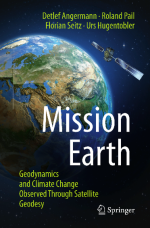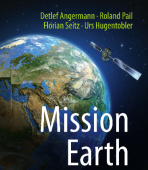News in 2022

|
Mission Earth
February, 2022
New Popular Science Book by D. Angermann, R. Pail, F. Seitz and U.
Hugentobler
 |
The book Mission Earth is aimed at interested
nonprofessionals who want to learn more about our
planet, but also at experts in natural sciences. readers are
taken on a journey through time from the first surveys in
ancient times to the satellite era, which is providing us with a
global view of our home planet. Using illustrative examples, the authors convey how deeply global positioning and navigation
with satellites pervade our daily life, and what fundamental
contributions geodesy makes to understanding the Earth system
and determining the effects of climate change.
The book can be ordered here
|
We have received the following review from Hansjörg Kutterer, DVW
How does your cell phone know where you are right now? How is our
planet changing due to geodynamic processes and ongoing climate change?
How can these changes be precisely measured from space? Such questions
are highly relevant for our society - and are answered by geodesy. The
central mission of the author’s team led by Dr. Detlef Angermann at the
Technical University of Munich is to illustrate and explain precisely
this. Thus, proven experts of global geodesy have come together to
present their profound knowledge accurately, factually correct and,
above all, easily accessible.
To understand the explanations, one does not need a degree in geodesy
and certainly not a corresponding specialization. The book is explicitly
written "for the curious". Formulas and derivations - unfortunately very
often an argument against an in-depth study of the subject - are not
found. Rather, our planet Earth with its complex dynamics is the focus
of interest - and with it the current achievements and future
possibilities of geodesy to contribute to a better understanding.
The book is divided into a total of five chapters. In a short
introduction, the Earth is presented according to the modern view of
systems theory as a dynamic planet, which consists of complex,
interacting subsystems such as solid Earth, atmosphere, oceans or ice
and which is subject to manifold changes. Climate change is already
emphasized in the introduction as an example that is particularly
visible to society. The chapter closes with the global view of geodesy
on the Earth - illustrated by the three "basic pillars": geometry and
kinematics, orientation and rotation, gravitational field. This
clarifies the focus of the book and distinguishes it from an overall
view of the geodetic portfolio.
Chapter 2 deals with the historical development of geodesy with
regard to questions, tasks and methods from the first surveys in
antiquity to the age of satellites. This storyline continues in
Chapter 3 to describe and explain the approaches, tools, and
contributions of global geodesy in the 21st century comprehensively, but
- following the objective and the page size - not exhaustively. In
Chapter 4, the focus of the considerations is put on the Earth system
with the phenomena of global change. This emphasizes that the
self-understanding of geodesy is not limited to a rather technological
level. Dynamic processes of the solid Earth body, sea level changes or
mass displacements in connection with the global water balance due to,
e.g., ice melting in the polar region, are treated in detail. Essential
statements about these changes, which affect us to a large extent in our
everyday lives, are based on the fundamental findings of geodesy.
Already the preceding chapters are excellently written and extremely
exciting to read. Finally, this is further enhanced in Chapter 5 by
three interviews with renowned experts who are also known to the broader
public. The content of this chapter is based on the societal relevance
of the highly precise measuring of our planet from space. Prof. G. Hein,
who played a key role in shaping the European satellite navigation
system Galileo, looks at the importance of navigation systems in modern
society. Prof. H. Lesch, known to a wider German audience through his
science broadcasts, takes a holistic look at the Earth system. Prof. S.
Rahmstorf, one of the lead authors of the Intergovernmental Panel on
Climate Change's Fourth Assessment Report and an advisor to the German
government, focuses on climate change and the threats it poses. The book
concludes with a summarizing epilogue and a series of recommended
readings to deepen and expand the presentations.
With this book, the authors have succeeded in an impressive way in
presenting modern geodesy - using the example of global geodesy - in a
lively and descriptive manner with regard to its possibilities and
achievements and in placing it in the scientific and societal context.
They have more than fulfilled their self-formulated claim, especially in
times of "fake news", to "write down what we know for sure because we
have measured it directly". Congratulations!
It is very worthwhile to read the book. Therefore, this book should
be widely distributed in our professional community and its neighboring
fields, in order to make the relevance and multitude of the geodetic
contributions known far beyond science in the narrower sense - and thus
to contribute significantly to the awareness and the positive image of
geodesy, also supporting the recruitment of young people for our
inspiring profession.
This book review is an authorized translation of the original
German “Buchbesprechung” by Hansjörg Kutterer, published in zfv –
Zeitschrift für Geodäsie, Geoinformation und Landmanagement, Heft
2/2021, 146. Jahrgang, Herausgeber: DVW e.V. – Gesellschaft für
Geodäsie, Geoinformation und Landmanagement, ISSN 1618-8950. The
translation was done with the help of artificial intelligence (machine
translation by the service DeepL.com).
Evelien Hertz - van Gelder
February 2022

























